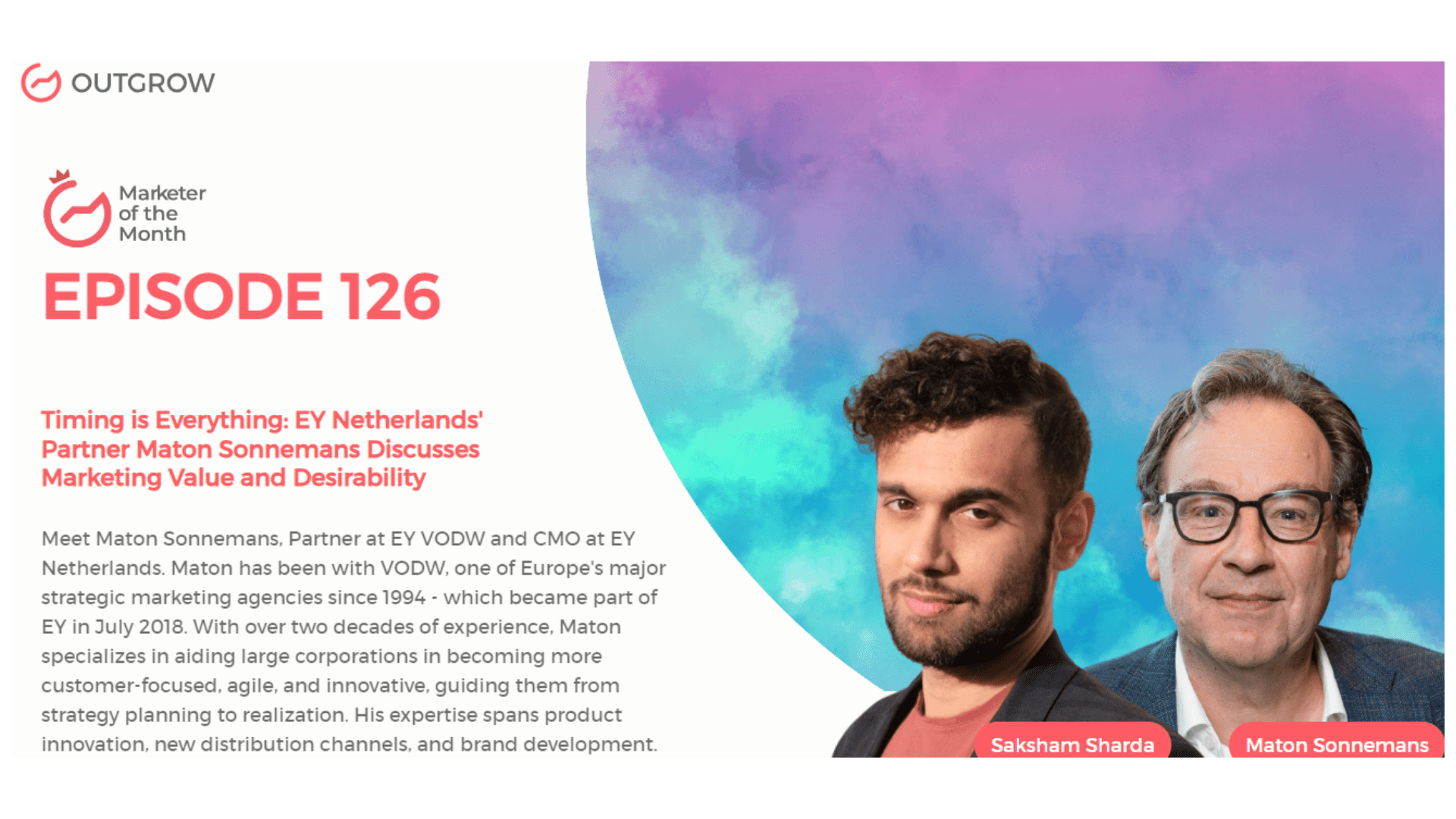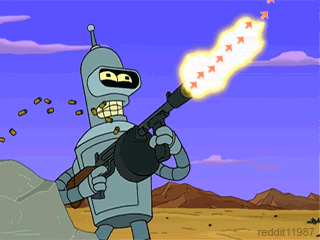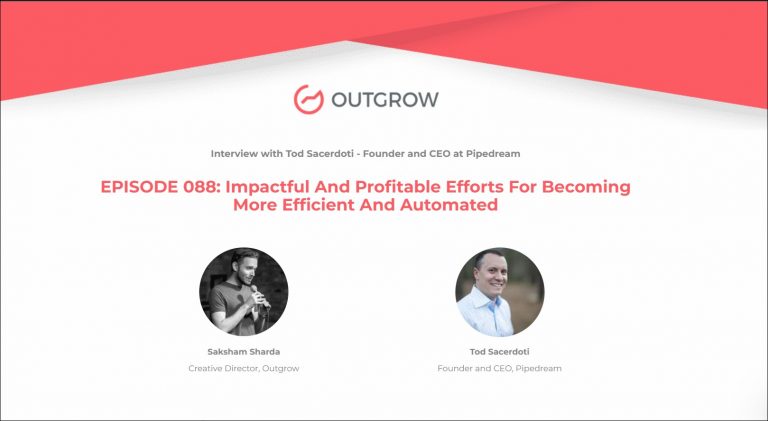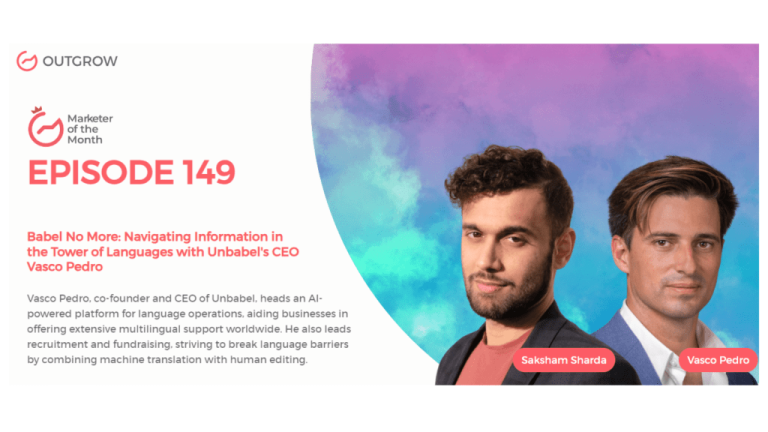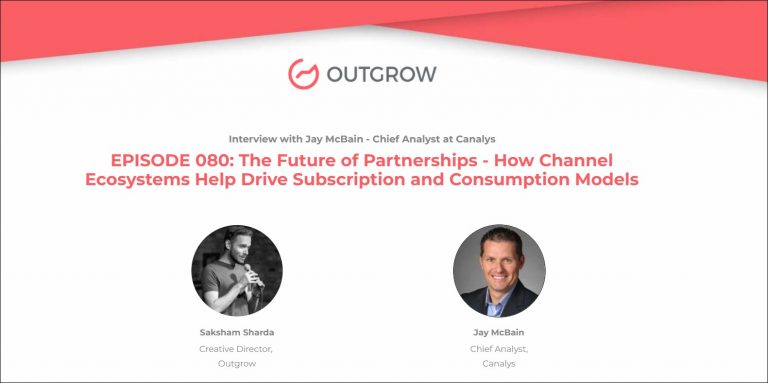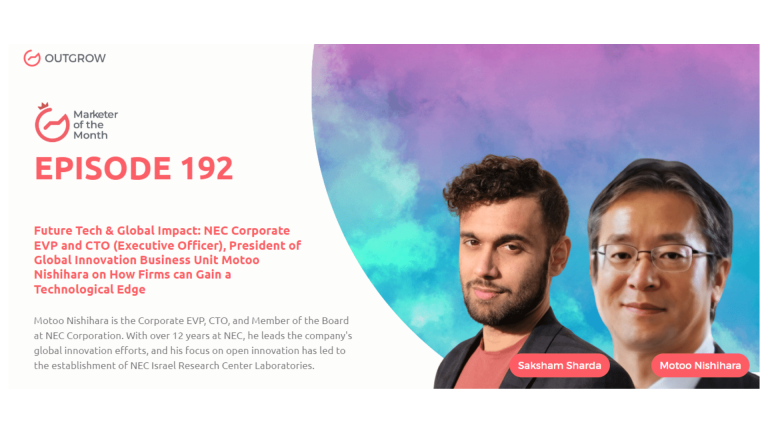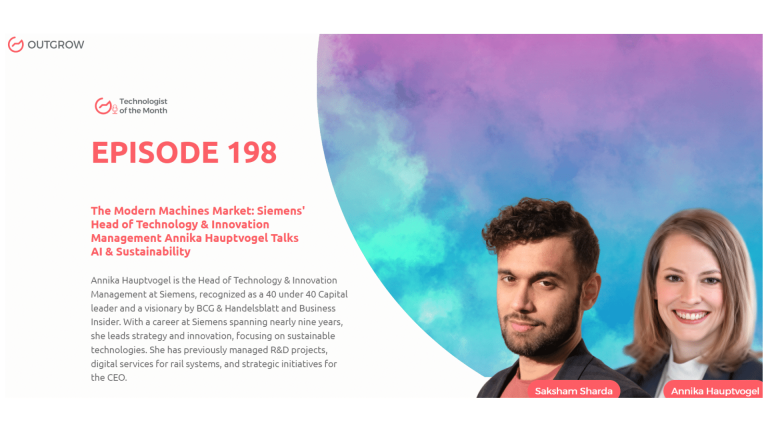EPISODE 126: Marketer of the Month Podcast with Maton Sonnemans
Table of Contents
Hey there! Welcome to the Marketer Of The Month blog!
We recently interviewed Maton Sonnemans for our monthly podcast – ‘Marketer of the Month’! We had some amazing insightful conversations with Maton and here’s what we discussed about-
1. Elements for Successful Transformation: Shared vision, urgency, and leadership support.
2. Recognizing the organization’s season of change to determine the urgency.
3. Launching Successful Products: Focus on creating added value for customers and ensuring desirability.
4. Data and Analytics in Decision-Making: Data is a starting point; creativity is crucial for marketing success.
5. Prioritizing customer value creation to drive shareholder value.
6. Changing Consumer Behavior and Marketing Trends: Cultural shifts, sustainability, and inclusiveness.
About our host:
Dr. Saksham Sharda is the Chief Information Officer at Outgrow.co. He specializes in data collection, analysis, filtering, and transfer by means of widgets and applets. Interactive, cultural, and trending widgets designed by him have been featured on TrendHunter, Alibaba, ProductHunt, New York Marketing Association, FactoryBerlin, Digimarcon Silicon Valley, and at The European Affiliate Summit.
About our guest:
Meet Maton Sonnemans, Partner at EY VODW and CMO at EY Netherlands. Maton has been with VODW, one of Europe’s major strategic marketing agencies since 1994 – which became part of EY in July 2018. With over two decades of experience, Maton specializes in aiding large corporations in becoming more customer-focused, agile, and innovative, guiding them from strategy planning to realization. His expertise spans product innovation, new distribution channels, and brand development.
Timing is Everything: EY Netherlands’ Partner Maton Sonnemans Discusses Marketing Value and Desirability
The Intro!
Saksham Sharda: Hi, everyone. Welcome to another episode of Outgrow’s Marketer of the Month. I’m your host, Dr. Saksham Sharda, and I’m the creative director at Outgrow. co. And for this month we are going to interview Maton Sonnemans, who is the Partner at EY VODW and CMO at EY Netherlands.
Maton Sonnemans: Great to be here. Thank you.
Don’t have time to read? No problem, just watch the Podcast!
Or you can just listen to it on Spotify!
The Rapid Fire Round!
Saksham Sharda: Alright, so let’s start with the rapid-fire round. The first is at what age do you want to retire?
Maton Sonnemans: 64.
Saksham Sharda: How long does it take you to get ready in the morning?
Maton Sonnemans: 25 minutes.
Saksham Sharda: The most embarrassing moment of your life?
Maton Sonnemans: Didn’t have one.
Saksham Sharda: Favorite color?
Maton Sonnemans: Blue.
Saksham Sharda: What time of day are you most inspired?
Maton Sonnemans: In the morning.
Saksham Sharda: How many hours of sleep can you survive on?
Maton Sonnemans: I need seven to eight hours.
Saksham Sharda: Fill in the blank. An upcoming marketing trend is _____.
Maton Sonnemans: AI.
Saksham Sharda: The city in which the best kiss of your life happened?
Maton Sonnemans: Amsterdam.
Saksham Sharda: Pick one, Mark Zuckerberg or Elon Musk?
Maton Sonnemans: Elon Musk.
Saksham Sharda: The biggest mistake of your career?
Maton Sonnemans: I didn’t make many mistakes.
Saksham Sharda: How do you relax?
Maton Sonnemans: Sporting.
Saksham Sharda: How many cups of coffee do you drink per day?
Maton Sonnemans: Four, I guess.
Saksham Sharda: A habit of yours that you don’t like?
Maton Sonnemans: Postponing things.
Saksham Sharda: The most valuable skill you’ve learned in life?
Maton Sonnemans: Being optimistic.
Saksham Sharda: Your favorite Netflix show?
Maton Sonnemans: I think La Casa De Papel.
Saksham Sharda: The last movie that you’ve seen that you liked?
Maton Sonnemans: Oh, that’s hard, I always forget them. “The Triangle of Sadness”.
Saksham Sharda: The last song you’ve been listening to that you liked?
Maton Sonnemans: Bryan Ferry, but I don’t know the song.
The Big Questions!
Saksham Sharda: Alright, That’s good. That was the end of the Rapid Fire round. So, the long-form questions, as a seasoned marketing professional with extensive experience in strategic innovation, what would you say are the key elements required to successfully drive transformation within commercial and marketing organizations?
Maton Sonnemans: Yeah, there are several key drivers of success. So, I think it all starts with a shared ambition and urgency on things because why do you want to change? Transformation is not the goal in itself. So it’s very good and important that you have an urgency and a real, let’s say, vision of why it is necessary to do this transformation. And this has to be sent out, by the leadership, of course. And then it’s very important to prove the idea of the transformation. So I always start with small-scale experiments that make other people not involved jealous. And then it is much easier to build further to scale that up in a later stage. So what you often see is that people are very much afraid of change. That’s a common habit. And then especially in the Netherlands, you see that when leadership decides on transformation, the discussion always starts over again. People want to rationalize why it’s also good to do other things. So the best thing is to prove the idea of the transformation is on a small scale, have the right people on board to do that, and yeah then scale it up. That’s how I do it.
Saksham Sharda: How do you determine the urgency or the vision, as you mentioned earlier, how do you determine that it is urgent?
Maton Sonnemans: Yeah, that’s something that people have to feel. So one of the things I often use is I don’t know if you know this S-Curve model where you say that every organism in the world, if it’s a tree or an organization or a human being, has a kind of s-curve in its life. So, it starts and then it grows, and then the growing is less. And then at the end of the, it dies, or it’s like a spring, summer, autumn and winter. So I often ask people in which season are you living in organizations? And then when people say okay we’re living in autumn or in winter, it’s time to do something, of course. So there are more and more elements where you can try to find out why it is urgent to change. And it’s very important so things in life have to be important enough and urgent enough to act. And if it’s urgent, but not important, people don’t act. And otherwise, if it’s important but not urgent, people won’t act as well.
Saksham Sharda: What are some of the most important factors to consider when launching a successful product in today’s fast-paced and competitive market?
Maton Sonnemans: If it has added value, for the customer, of course in my opinion everything starts with creating new added value for the customer. For me, another question always is a kind of sanity check. Would I sell it to my mother or my daughter? Is it a decent product? Is it something that is making the world a bit better?
Saksham Sharda: But is it possible to determine completely at the beginning whether a product is sellable or have there been instances where after a while it’s somehow caught traction?
Maton Sonnemans: Yeah, it’s not possible to give a hundred percent guarantee of success. But of course, it’s very good that you have a kind of discussion on the desirability of products and feasibility of products. and if there is also a kind of profitability behind it that makes it, let’s say, in an economic sense, sustainable. So I don’t believe in free products, for instance, because there’s always, there’s no such thing as a free lunch. So you have to create some value where there is enough profit potential in it that the company will keep this in or keep this in the loop of course. And that’s something that sometimes is forgotten. But desirability, of course, is a product desirable from a consumer perspective and is one of the most important and sometimes forgotten things in product-oriented companies. They like technology. They liked the ID by themselves but they didn’t validate it in the market.
Saksham Sharda: So what do you think of Apple’s new virtual reality glasses?
Maton Sonnemans: In this framework! I just talked about it of course being very upmarket, so I think it’s a game changer. It’s, of course, a toy for the boys for what it is, a price, three and a half thousand dollars or something like that. But it’s a starting point and yeah, I’m very curious how this will work out. But I think it’s at least an interesting innovation from Apple after a few years. So I like the idea, although I don’t like the idea of sitting in a room with my family, and I saw a commercial from Apple where a father was playing with his kid with his provision on, and I think that’s a for me, that’s also a scary image.
Saksham Sharda: So as a partner at Ernst And Young and CMO at Ernst And Young, you have undoubtedly encountered numerous challenges throughout your career. Could you share a particularly complex marketing-related problem you’ve faced and the innovative solution that you perhaps implemented to overcome it?
Maton Sonnemans: Yeah. First of all, it’s good to mention that the name Ernst and Young, by the way, was already rebranded 10 years ago into EY, but still, people talk about Ernst Young. So you see how hard it is to change habits, and that’s one of the main problems of course in marketing, that sometimes you have a good idea, but it’s really hard to change the habits of people. And this proves it, I guess. So yeah, of course, there is a wide priority of challenges we encounter. And mainly what I see is that there is a big gap between the ambition of a company, which is sometimes formulated by companies like ours or the big consult strategy firms. And that there is a total gap between this ambition and the capability of an organization. So it’s like saying that your ambition is to play in the major league, but the organization is not capable of doing that. And this is a problem when companies state certain marketing strategies and then you see that the organization is not able to be more data-driven or to be more customer-centric, or more innovative. So many big companies, you, of course, see that really important dry capabilities like innovative power or entrepreneurial skills are scarce. And that’s a problem in closing these gaps. So our job is on the one hand to make this ambition more realistic. So saying okay this is not possible for you, but this is possible. And on the other end working on the capabilities of an organization to close this gap is how to say and that’s what we often do in teams.
Saksham Sharda: What’s the usual reaction to your company telling some companies that they need to be more realistic in their approach?
Maton Sonnemans: Yeah, it differs. So, sometimes we have to tell this client that they have to be more realistic, and people like it sometimes, and, some big egos don’t like it because they have already announced it. So, they are afraid of getting this reality check. Although some companies are not ambitious enough and we say, okay if you want to play the game with the upcoming competition you have to be more ambitious. And that’s an even more difficult discussion. So it’s easier to break than to accelerate in companies. But yeah, it’s wherever you ask for and you have to do that in a polite way. So being strict and of course, having the right arguments to say that and helping them. And so what we do is not advising people, but working with people together. So, the time that consultants only give advice in a PowerPoint and say okay this is what you should do. Good luck is over that’s over. Nowadays, we work together with our clients in multidisciplinary teams. And it’s a joint decision you make. So it’s not that we say you are not ambitious enough, or you have too much ambition, but it’s what we say together as a client. So what we always say at the end of a project is it shouldn’t be our project from EY, but it should be the project of a client. They should own it and then it’s okay but sometimes they need this outside view to make it more sharp. That’s what we do.
Saksham Sharda: So to pivot a little being on the board of the Netherlands Blazers and Ensemble, how do you combine your passion for music and the arts?
Maton Sonnemans: Oh, if you’re doing your background studies.
Saksham Sharda: Yes, with your professional work in marketing and strategy.
Maton Sonnemans: You always have to do things that give you new inspiration. And for me, personally, is that I like the world of art as a source of inspiration for business. So that’s why I was on this board. I had to end it after eight years. That’s due to cultural governance in the Netherlands this year. So, it was a great time. I love to work with artists and other cultural people because what they do is ask critical questions in society. That’s what good artists do. That’s why also we at EY started an arts and culture front where we now are a main sponsor of the Dutch Film Festival and the Dutch Design Week because we see that these young artists often ask critical questions for making a better world. They dare to discuss the conventions in the world, and that’s what artists do more than business people. But business people can learn a lot from that. What artists also do is find new ways, new combinations of expertise bringing together, combining different visions, and making new, new images for the future. So that’s why I like to be working on these kinds of boards in my spare time.
Saksham Sharda: Do you do any kind of art to yourself?
Maton Sonnemans: No, actually not yet. But you ask about my age of retirement maybe later. When I was young, I applied for the Dutch Design Academy. I didn’t get access to that. So I went to study business administration. I’m still an art lover and a design lover, but maybe when I’m 64, I’ll pick up art again.
Saksham Sharda: Would you consider marketing and art?
Maton Sonnemans: Yeah, Marketing is in fact, art and science. It’s on the one hand scientific, working on really thinking on insights based on data, based on analysis of where there are gaps in certain situations whether it’s in product portfolios, customer experience, or brand reputation. And on the other hand, good marketing is still about art. It’s finding new ways to be original being a rebel with a course So doing things that are not evident.
Saksham Sharda: So, what is your rationale behind your statement, we picked this from the internet, “Creating customer and social value automatically leads to shareholder value rather than the other way around.” Do you elaborate on why you strongly believe in this perspective?
Maton Sonnemans: Yeah, that’s already a thing, I strongly believe for many years that I have worked for a lot of big companies, and what I often see is that many boards and companies always take shareholder value as the starting point and the main objective. And my strong belief is that if you only talk about shareholder value, it won’t create customer value. But if you talk about customer value, it always creates shareholder value. To give you an example, if you talk about shareholder value, it is easy to conclude that, for instance, you should reduce the cost of your customer service department because it could save you 10 million euros per year. That’s easily found money to create more shareholder value. But on the other hand, it also reduces the customer value in a very bad way, potentially. And if you do it the other way around, if you find ways to increase the customer value and do things that are relevant and distinctive for your customers, I’m convinced that shareholder value will follow, that people will recognize that and think, okay, this is a really, a good company for clients. Shareholders are also consumers. So many shareholders also have to buy products so they know if this is a good company.
Saksham Sharda: So with over three decades of experience in strategic advice, what major shifts have you observed in consumer behavior and expectations over the years? And how can marketers adapt to effectively engage with today’s digitally empowered consumers?
Maton Sonnemans: Yeah, I’ll make it a long story short. So of course what you see is that there’s changed a lot. Of course, 30 years ago there was no internet, there was no email, there was no mobile phone. Many things were not there. So it’s really funny to realize that at that time we already did some marketing but it was more on product and maybe a bit on customer experience, but not much. So what you have seen is that things like customer experience and personalization based on data have become much more important over the last 30 years and much more possible because it’s also easier to design it in a digital way. It’s very hard to design a customer experience for your Salesforce when they’re all outside in the market or for people in shops.
Maton Sonnemans: It is possible but more difficult to do that for digital processes. So that changed a lot. I guess on the other hand people are still looking for trustworthy companies to deliver the promise that companies have to make for being good. I think that what becomes more and more important is of course the item of sustainability and inclusiveness. So companies have to be much more aware of doing the good things in a good way. Yeah, let’s have a look at the Budweiser case, which is an act right now in the US, it went wrong in all dimensions. So it’s more difficult right now. It’s a delicate game that would change a lot. In my opinion, marketing in that case is more and more not a department that has to convince consumers to change but has to be the department that has to convince the internal organization to change. So in fact we have to have a vision into the company how this company should change to become more acceptable and desired by consumers. What’s much more important than pushing products to customers?
Saksham Sharda: So, what role do you think data and analytics play in your decision-making process when it comes to developing new products and marketing initiatives?
Maton Sonnemans: It’s a very important role. It’s a starting point in analyzing opportunities but data and analytics never provide you with a solution. In the box out there is when you have the right analytic reports then you can start being creative. So it’s for me a starting point to build on your creativity.
Saksham Sharda: The last question for you is of a personal kind, what would you be doing in your life, if not this right now?
Maton Sonnemans: I always said that I would probably be in my next life but otherwise, maybe I would become a writer of novels not of management books. I hate management books. There are always 600 pages and you could write them in 10 pages because there’s always a lot of waste in these books.
Let’s Conclude!
Saksham Sharda: Thanks, everyone for joining us for this month’s episode of Outgrow’s Marketer of the Month. That was Maton Sonnemans, who is the Partner at EY VODW and CMO at EY Netherlands.
Maton Sonnemans: Pleasure. Thanks for having me.
Saksham Sharda: Check out the website for more details and we’ll see you once again next month with another marketer of the month.
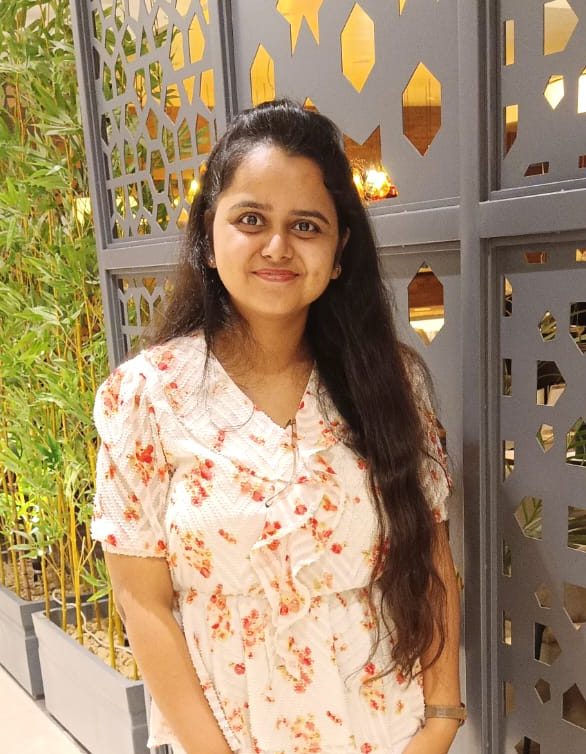
Muskan is a Marketing Analyst at Outgrow. She is working on multiple areas of marketing. On her days off though, she loves exploring new cafes, drinking coffee, and catching up with friends.

